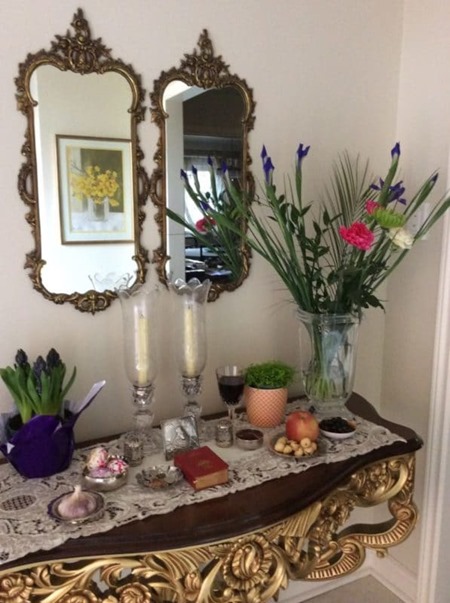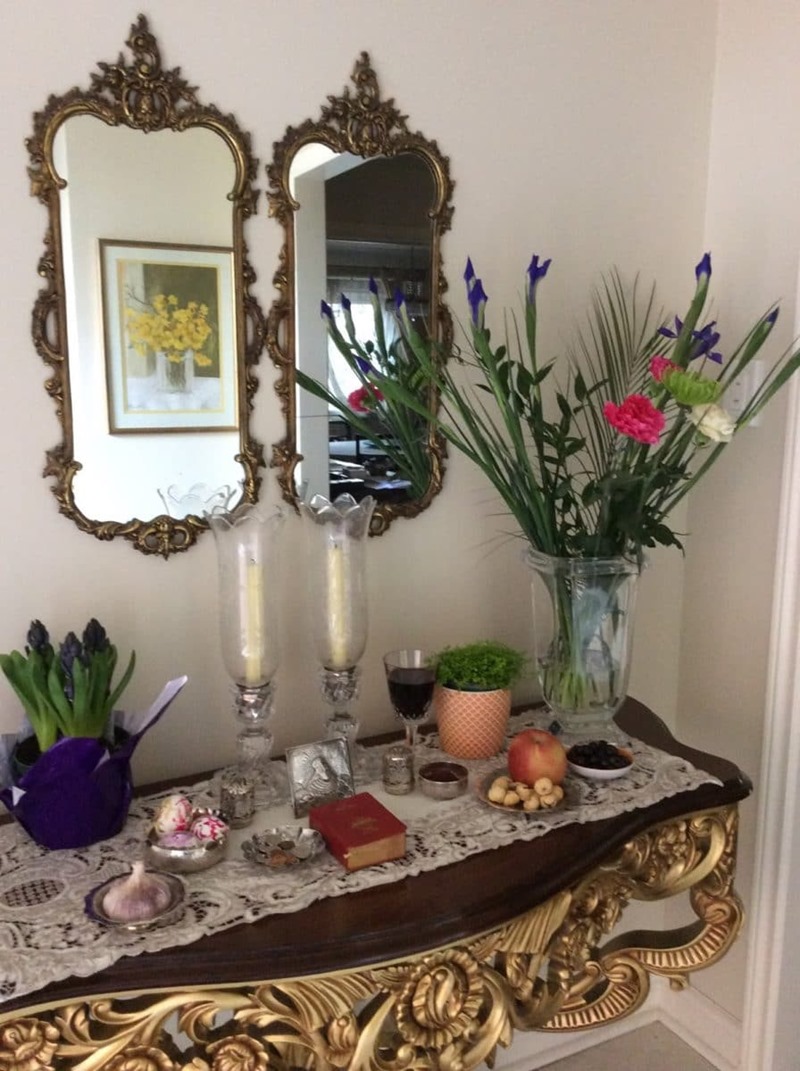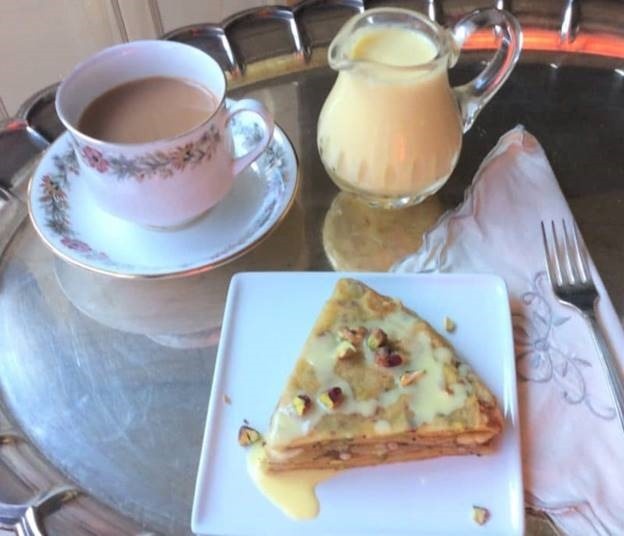Niloufer is a cookbook author and cooking instructor with a great passion for food and a love of world travel.
The people from Pars – a province in the Persian Empire — migrated to Gujarat, India, 2500 years ago. Persecuted, most of them fled, taking with them their rich culture, heritage, traditions and cuisine. The locals referred to them as Parsis, which continues to date.
Article by Niloufer Mavalwala | The Cooks Cook
Adopting and adapting to many of the local traditions, the Parsis are a success story for India. What we lack in having a flag or a nation to call our own we make up in rather large strides in every sector of the economy. We continue to leave an indelible mark wherever we live: the Covid vaccine by the Poonawala family, Freddy Mercury, and maestro Zubin Mehta, to name a few.
Persian and Parsi food have many commonalities. Both tend to love sweets, adding fruit and nuts to both savory and sweet dishes, and cook with spices like cinnamon, cardamom, nutmeg and cloves. They also share the method of cooking meats in yogurt and milk, uncommon in other cuisines.
Saffron – the dried stigma of the crocus bulb is very special to us. Rose and citrus, like orange and lemons, are also a must in both cuisines. Vinegar, jaggery and tamarind are favorites. Eggs and garlic are incorporated in many ways. Interestingly, unrefined jaggery sugar has often been dropped from modern day recipes, but its health benefits and increasingly easier access around the world has made it an ingredient worth reviving.
Festivities like Navroze or “New Day” – Naurooz in Farsi — marks the first day of the Spring Equinox and is eagerly celebrated. Falling on March 20th/21st of each year it marks the end of winter and reminds us to cleanse our homes to start afresh for the year ahead. The occasion is celebrated with friends, families, and neighbors, sharing whatever one is fortunate enough to have.
Neighbouring countries also celebrate Navroze. It is estimated that over 190 million people mark this occasion every year.
Traditionally every home prepares a Haftseen table, a symbolic tribute to the seven creations of the universe – fire, water, air, earth, metal, the plant and animal kingdom. The table features candles, a mirror, coins, flowers, painted eggs, nuts and dry fruit, and gold fish.
 In addition, seven items beginning with the letter S are offered as thanks for the abundance in one’s home, and with hope for continuity into the days to come.
In addition, seven items beginning with the letter S are offered as thanks for the abundance in one’s home, and with hope for continuity into the days to come.
Sumac – dried berry powder represents sunrise
Semanu – sweet semolina pudding
Seb – apple representing health and beauty
Sabzi – greens or lentils representing life and rebirth
Seer – garlic representing health
Senjed – olives representing love
Serkeh – vinegar representing age and patience
This festivity founded by the Zoroastrian King Jamshed the Great of the Persian Empire centuries ago continues to be an important part of modern-day Iran and is celebrated over several days.
The dining table offers a buffet to all who come visit the family bearing gifts like sweets, flowers and wine. It often has a meat, fish and vegetable. Sweets of choice and homemade cheese, laid out with fruits like pomegranates and clementines, complete the table. An offering of rose water is splashed for its perfume on guests, and each person looking into the mirror makes a wish for the year ahead, making for a light-hearted event.
While there are plenty of recipes that are prepared for this occasion, I would like to share two of them here. Intricately entwined with my Persian and Indian heritage, the first includes dry fruit and nuts and fresh coconut. Chaapat (pronounced Chaa- putt) is a simple delectable pancake – I have dressed it up with thinly rolled out marzipan between the layers and served with a crème anglaise. The other is copra na pancake using a French-style crèpe to fill with a fragrant rose and cardamom-speckled coconut filling.![]()
Chaapat — Parsi Sweet Pancake
Chaapat or Parsi crèpes/pancakes are easy to make. Chaapat is pronounced as Cha- puttt and can simply mean “flat.” They are an old favorite from the past, when lots of treats were made from real coconut milk, laced with nuts and little sugar, to enjoy with a cup of tea. As in most traditional foods, every family had their secret recipe to making their very own version of the same dish. This one is shared from my mother-in-law’s family who were all excellent chefs making traditional Parsi food.
Ingredients
For the Chaapat:
- 473 ml (2 cups) canned coconut milk
- 200ml (7ounces wt.) sifted all-purpose flour
- 200ml (7ounces wt.) sugar
- 4 eggs
- 7.5 ml (1/2 tablespoon) melted ghee
- 30 grams (1 ounce wt.) almonds, blanched and grated (See Notes)
- 15 grams (1/2 ounce wt.) chopped pistachios
- 5 ml (1 teaspoon) vanilla extract
- 2.5 ml (1/2 teaspoon) cardamom powder
- 1.2 ml (1/4 teaspoon) freshly scraped nutmeg
- 1/2 tsp saffron threads (see Notes)
For the Crème Anglaise:
- 473 ml (2 cups) milk
- 8 egg yolks
- 125 grams (1/2 cup) sugar
- Choice of flavorings: traditional – add 15 ml (1 tablespoon) of vanilla extract, or add 5 ml (1 teaspoon) vanilla and 5 ml (1 teaspoon) coffee granules, or 5 ml (1 teaspoon) vanilla and 15 ml (1 tablespoon) rum, or 5 ml (1 teaspoon) vanilla and the zest of a lime or lemon.
Notes: The nuts chosen here are sweet. Substitute with your favorite ones. Macadamia nuts are the closest to these ones. Charoli, commonly found in India and in their larger Indian stores across Canada and the UK is also a great addition to the recipe. Roughly chop the Charoli before adding them.
Crush the saffron threads to help blend into the mixture. If you store the box of saffron in the fridge, it will crisp up and make it easier to crush. Use the tips of your fingers!
If you do not wish to buy ghee, clarified brown butter is just as good. Simply melt and simmer 4 ounces of butter until it separates and changes its color. Use as needed.
Preparation
- For the chapaat: Heat a small 5 inch/13cm skillet and a drop of ghee and pour a ladle of the mixture. Tilt the pan in circles so the mixture spreads around evenly covering the bottom base of the pan. Lower the heat and allow it to cook for a minute until a pale golden brown. Carefully flip it over and cook for another minute. Serve warm.
2. For the crème Anglaise: In a glass measure cup scald the milk. In a heavy bottom pan, stir 8 egg yolks with the sugar. Mix it well with a wooden spoon breaking it all up properly, then add a pinch of salt. Now add the milk slowly to the eggs mixing it vigorously and quickly to emulsify the mixture.
3. Set aside a plastic sieve set over a glass bowl in a bath of iced water. Against all odds and other norms, cook the mixture on a fairly high heat always remembering to mix it continuously, only until the mixture thickens to coat the back of the wooden spoon. Do not boil. Flavor as desired. To flavor it you have several choices: traditional – add 15 ml (1 tablespoon) of vanilla extract, or add 5 ml (1 teaspoon) vanilla and 5 ml (1 teaspoon) coffee granules, or 5 ml (1 teaspoon) vanilla and 15 ml (1 tablespoon) rum, or 5 ml (1 teaspoon) vanilla and the zest of a lime or lemon.
4. Strain the crème Anglaise immediately. Mix it to stop forming a skin on top or place a cling film over it touching the crème.
Notes: If you are using vanilla bean, split the bean and remove the pulp, adding it to the milk before heating the infuse it at its best. If not add the vanilla extract at the very end.
Mix and keep the batter for up to 24 hours covered in the fridge if you need to.
If it becomes thick add some milk to bring it to the right consistency.
If it is thinner, refrigerate and wait for an hour or two for it to thicken as the gluten in the flour will help do just that.
If you are not confident of turning the pancake, simply cover the skillet with a lid and cook through. Fold the pancake and serve both sides will show up as a beautiful golden brown!
Delicious delight!
Copra Na Pancake is a favorite Parsi tea-time treat, filled with coconut, dried fruit, and nuts.
Ingredients
For the Crèpes:
- 2 eggs, at room temperature
- 60 grams (1/2 cup) sifted all-purpose flour
- 5 ml (1 teaspoon) baking powder
- Pinch of salt
- 237 ml (1 cup) warm milk
- 30 ml (2 tablespoons) salted butter, melted
For the Coconut Filling:
- 2 scraped coconuts; 473 ml (2 cups) or more (frozen scraped coconut may be purchased from Indian and specialty food stores)
- 198 grams (1 cup) sugar
- 120 ml (1/2 cup) mixed dried fruit and nuts (raisins, peeled chopped pistachios and almonds)
- 120 ml (1/2 cup) coconut water*
- 60 ml (1/4 cup) rose water (not rose essence)**
- 5 ml (1 teaspoon) salted butter
- 5 ml (1 teaspoon) cardamom
- 5 ml (1 teaspoon) nutmeg
- Pinch of salt
*If you cannot get fresh coconut water substitute water flavored with a few drops of vanilla.
**Rose water must not be an essence but the actual water made from roses steeped in distilled water.
Preparation
- For the crèpes*: In a bowl beat the eggs until frothy and light.
2. In separate bowl mix together the flour, baking powder, salt, warm milk, and melted butter until smooth and free of lumps. Add the beaten egg to the mixture and stir to combine. Allow the batter to rest and thicken at room temperature for 30 minutes before making the crèpes.* Meanwhile, prepare the coconut filling.
3. For the coconut filling*: In a large saucepan, combine all filling ingredients. Place over medium-low heat and stir gently until the mixture is softened and well blended. Remove from heat and set aside.
4. For assembly: Lightly brush a nonstick 18 cm (7-inch) crèpe pan or skillet with ghee or clarified butter. Place over high heat until hot. Add a ladleful of batter and swirl the pan to ensure it spreads evenly all over. Lowering the heat, let it cook until a pale golden brown, about 2 minutes. With a flat spatula, carefully flip it over and cook for another minute until golden brown. Allow the pan to reheat before adding new batter, and stack the crepes are they are removed from the pan.*
5. Divide the filling into ten portions. Spread each crèpe with a portion. Fold into quarters and arrange decoratively on a serving plate.
Tips for making the filling:
*Once the crèpes are made they can be frozen for up to 1 month. Frozen crèpes are best for use in baked dishes with sauces, as the consistency changes slightly once frozen. Cool completely before freezing. Stack them with buttered parchment between each one, or simply freeze in batches of 10. To avoid freezer burn be sure to cover tightly with airtight wrap. To thaw, bring each batch to room temperature; place in a warm oven for 10 minutes if you have trouble separating the individual crèpes.
**The filling can be made up to 7 days in advance and kept refrigerated.
Born and raised in Karachi, with London, Toronto and Dubai all part of her life, Niloufer has travelled extensively. Passionate about culture through its cuisine she enjoys all cuisines of the world. Self taught, her experience through the years has driven her to write a blog NiloufersKitchen.com and publish two Parsi cookbooks – receiving 3 awards. She strongly believes that while we are identified by race, religion and colour, we share the tightest bonding through food. Her umpteen zoom demos through this pandemic have picked up momentum worldwide making #revivinganancientcuisine one recipe at a time her priority. Niloufer runs regular cookery lessons via Zoom.
Courtesy photo




